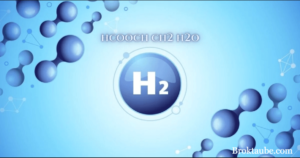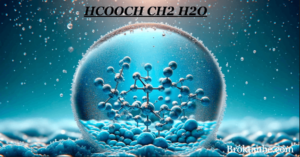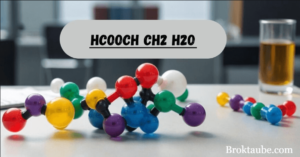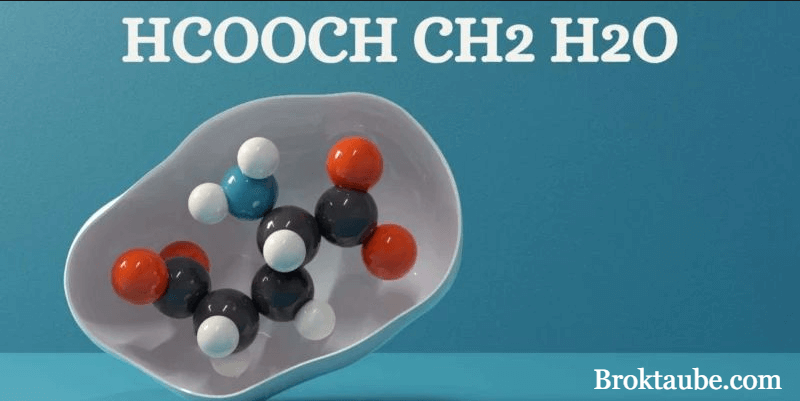When I stumbled upon HCOOCH CH2 H2O during my chemistry studies, I couldn’t help but be intrigued. This compound, often brushed aside in textbooks, holds a wealth of secrets that can shape our understanding of organic chemistry. You might be surprised by its wide-ranging applications—from pharmaceuticals to industrial practices.
What is HCOOCH CH2 H2O?

Have you ever come across the term HCOOCH CH2 H2O? If you’re diving into organic chemistry, this compound is one you should know about. Let’s break it down together.
Definition of HCOOCH CH2 H2O
HCOOCH CH2 H2O is an ester compound. But what does that mean? In simple terms, esters are formed from the reaction of an alcohol and an acid. They often have fruity smells and are used in flavorings and fragrances. HCOOCH specifically refers to a compound that includes a formate group, which is derived from formic acid.
Structure and Formula Breakdown
Now, let’s look at the structure. The molecular formula for HCOOCH CH2 H2O is C3H6O2. This tells you that the compound contains three carbon atoms, six hydrogen atoms, and two oxygen atoms. Here’s a quick breakdown:
- C
- H
- O
The structure includes functional groups that are crucial for its reactivity. The presence of the ester functional group (–COO–) is what makes HCOOCH CH2 H2O behave the way it does in chemical reactions. This is important for understanding how it interacts with other compounds.
Significance in Organic Chemistry
Why should you care about HCOOCH CH2 H2O? This compound plays a significant role in organic chemistry. It’s not just a random molecule; it’s involved in various reactions that are fundamental to the field. For instance, esters like HCOOCH are often used in the synthesis of other organic compounds. They can serve as intermediates in chemical reactions, making them valuable in both academic research and industrial applications.
As one expert puts it,
“Understanding compounds like HCOOCH opens up new avenues in organic chemistry.”
This highlights the importance of studying such compounds.
Comparison with Similar Compounds
When you think about HCOOCH CH2 H2O, it’s helpful to compare it with similar compounds. For example, consider acetic acid (CH3COOH) and ethyl acetate (C4H8O2). Both are esters, but they differ in structure and properties.
Here’s a quick comparison:
- Acetic Acid: A simple carboxylic acid with a pungent smell. It’s commonly found in vinegar.
- Ethyl Acetate: A more complex ester with a sweet smell, often used as a solvent in nail polish remover.
While HCOOCH CH2 H2O shares some similarities with these compounds, its unique structure and properties set it apart. Understanding these differences can help you grasp its applications better.
Key Data Points
Here are some important data points about HCOOCH CH2 H2O:
- Molecular Formula: C3H6O2
- Density: 1.1 g/cm³
This information is crucial for chemists when they are working with this compound. Density, for instance, can affect how HCOOCH behaves in different environments.
Conclusion
In summary, HCOOCH CH2 H2O is more than just a chemical formula. It’s a compound with significant implications in organic chemistry. From its structure to its applications, understanding this ester can open doors to new knowledge and innovations in various fields, including pharmaceuticals and industrial chemistry.
Chemical Properties of HCOOCH CH2 H2O
Understanding the chemical properties of HCOOCH CH2 H2O is essential for anyone working in chemistry or related fields. This compound has unique characteristics that influence its behavior in various environments. Let’s break down these properties one by one.
1. Physical State and Appearance
HCOOCH CH2 H2O is typically found in a liquid state at room temperature. It has a clear, colorless appearance, which makes it visually similar to water. This clarity can sometimes lead to confusion, especially in laboratory settings. You might wonder, how can such a simple appearance hold so much potential? The answer lies in its chemical structure.
2. Melting and Boiling Points
When it comes to temperature, HCOOCH CH2 H2O has specific melting and boiling points that are crucial for its applications. The boiling point is around 103 °C, while the flash point is significantly lower at 30 °C. This means that it can easily vaporize at relatively low temperatures, making it important to handle with care. Why does this matter? Well, knowing these points helps in designing safe experiments and industrial processes.
3. Reactivity with Other Chemicals
HCOOCH CH2 H2O is known for its reactivity with various chemicals. It can participate in several chemical reactions, making it a versatile compound. For instance, it can react with acids and bases, which can lead to the formation of esters or other derivatives. This reactivity is a double-edged sword. On one hand, it allows for a wide range of applications; on the other, it requires careful handling to avoid unwanted reactions.
“The unique properties of HCOOCH make it a versatile compound for chemical reactions.”
4. Solubility Characteristics
Solubility is another critical property of HCOOCH CH2 H2O. It is soluble in water, which is a significant advantage in many applications. This solubility allows it to be easily mixed with other substances, facilitating various chemical processes. But what does this mean for you? If you’re working in a lab, it means you can use HCOOCH in aqueous solutions without worrying about it precipitating out.
5. Importance of These Properties
Each of these properties contributes significantly to the applications of HCOOCH in laboratory experiments and industry. For example, its physical state and appearance allow for easy identification, while its boiling point is crucial for processes that involve heating. The reactivity with other chemicals opens doors to new reactions and products, and its solubility characteristics make it a useful solvent.
In summary, understanding the chemical properties of HCOOCH CH2 H2O is not just an academic exercise. It has real-world implications. Whether you’re conducting experiments in a lab or working in an industrial setting, knowing these properties can help you make informed decisions. So, the next time you encounter HCOOCH, remember its boiling point, reactivity, and solubility. These factors are key to unlocking its potential in your work.
Applications of HCOOCH CH2 H2O
HCOOCH CH2 H2O, also known as formate, is a compound with a wide range of applications. Its versatility makes it a valuable asset in various industries. Let’s explore how this compound is utilized in different fields.
1. Use in Solvents
One of the primary applications of HCOOCH is in the production of solvents. Solvents are crucial in many industrial processes. They dissolve, suspend, or extract other substances. In fact, common solvents containing esters, like HCOOCH, account for approximately 30% of all industrial solvents used today.
Why is this important? Solvents are essential for creating paints, coatings, and adhesives. They help in the formulation of cleaning products and personal care items. The ability of HCOOCH to dissolve a variety of substances makes it a preferred choice in these applications.
2. Role in Synthetic Chemistry
HCOOCH plays a significant role in synthetic chemistry. It serves as a building block for various chemical reactions. This compound can participate in esterification and transesterification reactions. These processes are vital for creating new materials and chemicals.
Imagine a chef using different ingredients to create a unique dish. Similarly, chemists use HCOOCH to create new compounds. Its adaptability allows it to fit into various chemical scenarios. This flexibility is what makes it so valuable in research and development.
3. Applications in Pharmaceuticals
The pharmaceutical industry also benefits from HCOOCH. It is used in the synthesis of active pharmaceutical ingredients (APIs). These are the substances in medications that produce the desired effects. HCOOCH can help create compounds that are effective in treating various conditions.
For instance, certain medications rely on esters for their effectiveness. HCOOCH can be a key component in these formulations. Its role in drug development is crucial, as it can enhance the solubility and bioavailability of drugs.
4. Environmental Applications
In recent years, there has been a growing focus on environmental applications of HCOOCH. This compound can be used in processes that reduce pollution and waste. For example, it can serve as a biodegradable solvent, which is less harmful to the environment compared to traditional solvents.
Moreover, HCOOCH can play a role in the treatment of wastewater. Its ability to break down harmful substances makes it a candidate for environmental remediation efforts. By using HCOOCH, industries can work towards more sustainable practices.
5. Enhancing Efficiency in Production Processes
HCOOCH is utilized widely in various production processes, enhancing efficiency. Its properties allow for smoother operations in manufacturing. By incorporating HCOOCH, companies can improve their productivity and reduce costs.
Examining case studies can illustrate its effectiveness. For example, a company that switched to HCOOCH-based solvents reported a significant decrease in production time. This not only saved money but also improved product quality.
6. Real-World Relevance
Understanding real-world applications helps in grasping the relevance of this compound today. HCOOCH is not just a chemical; it’s a vital part of many industries. From pharmaceuticals to environmental solutions, its impact is far-reaching.
“The versatility of HCOOCH lies in its ability to adapt to various chemical scenarios.”
This quote encapsulates the essence of HCOOCH. Its adaptability makes it a key player in multiple fields. Whether you’re in manufacturing, pharmaceuticals, or environmental science, HCOOCH has something to offer.
In conclusion, HCOOCH CH2 H2O is a compound with diverse applications. Its role in solvents, synthetic chemistry, pharmaceuticals, and environmental efforts showcases its importance. As industries continue to evolve, the significance of HCOOCH will likely grow.
Environmental Impact of HCOOCH CH2 H2O

When we talk about chemicals like HCOOCH CH2 H2O, it’s not just about their uses in industry. It’s also about their impact on the environment. Understanding this impact is crucial for sustainable practices. So, what exactly should you know about the environmental footprint of this compound? Let’s break it down.
1. Biodegradability Concerns
One of the first things to consider is biodegradability. Can HCOOCH CH2 H2O break down naturally? The answer is not straightforward. Some compounds degrade quickly, while others linger in the environment. This persistence can lead to accumulation in ecosystems, which is a concern.
Why does this matter? If a chemical doesn’t break down, it can affect soil and water quality. It can also harm wildlife. You might wonder, how long does it take for HCOOCH CH2 H2O to degrade? Research shows that it has a moderate biodegradability rating. This means it doesn’t break down as quickly as some other substances.
2. Toxicity in Aquatic Systems
Next, let’s discuss toxicity. HCOOCH CH2 H2O has a moderate toxicity rating in aquatic life. This means it can be harmful to fish and other aquatic organisms. If it enters water bodies, it can disrupt ecosystems. Fish might suffer from reduced reproduction rates or even death. This raises an important question: how can we minimize this risk?
- Limit usage near water bodies.
- Implement proper containment measures.
- Monitor water quality regularly.
By taking these steps, you can help protect aquatic life from harmful effects.
3. Regulatory Considerations
Regulations play a significant role in managing the environmental impact of chemicals. Governments worldwide have established guidelines for the safe use and disposal of substances like HCOOCH CH2 H2O. These regulations aim to minimize risks to human health and the environment.
Are you aware of the regulations in your area? It’s essential to stay informed. Compliance with these rules not only protects the environment but also helps your business avoid legal issues. Remember, “Addressing environmental impacts is essential for the future of chemical engineering.”
4. Best Practices for Disposal
Disposal of HCOOCH CH2 H2O is another critical aspect. Improper disposal can lead to contamination of soil and water. So, what are the best practices for disposing of this compound?
- Follow local disposal regulations.
- Use designated disposal facilities.
- Educate employees about safe disposal methods.
By adhering to these practices, you can significantly reduce the environmental impact of HCOOCH CH2 H2O.
Real-World Implications
It’s vital to assess the real-world implications of using chemicals like HCOOCH CH2 H2O. The effects on ecosystems, human health, and regulatory compliance are all interconnected. If we ignore these factors, we risk damaging our environment.
Have you ever thought about how your actions impact the planet? Every decision counts. Whether you’re a business owner or a consumer, being aware of the environmental footprint of chemicals is crucial. It’s not just about what you use; it’s about how you use it.
Conclusion
In summary, the environmental impact of HCOOCH CH2 H2O encompasses several factors, including biodegradability, toxicity, regulatory considerations, and disposal practices. By understanding these aspects, you can make informed decisions that contribute to a healthier planet.
Safety Measures: Working with HCOOCH CH2 H2O

When working with chemicals like HCOOCH CH2 H2O, safety should always be your top priority. This compound, while useful in various applications, can pose risks if not handled properly. Let’s explore essential safety measures to ensure a safe working environment.
Required Safety Gear
Before you even think about handling HCOOCH CH2 H2O, you need to gear up. The right personal protective equipment (PPE) is crucial. Here’s what you should wear:
- Gloves: Use chemical-resistant gloves to protect your hands from potential irritation or burns.
- Goggles: Safety goggles will shield your eyes from splashes and harmful vapors.
- Lab Coat: A lab coat provides a barrier against spills and splashes, keeping your skin safe.
Remember, your safety gear is your first line of defense. Don’t skip it!
Handling Precautions
Handling HCOOCH CH2 H2O requires careful attention. Here are some key precautions to keep in mind:
- Work in a well-ventilated area: Ensure good airflow to minimize inhalation risks.
- Use fume hoods: If available, work under a fume hood to further reduce exposure to harmful vapors.
- Avoid skin contact: Always use tools or equipment to handle the substance, rather than your bare hands.
- Do not eat or drink: Never consume food or beverages in the lab to prevent contamination.
These precautions can significantly reduce the risk of accidents. Ask yourself: Is it worth taking shortcuts when your safety is at stake?
Storage Recommendations
Proper storage of HCOOCH CH2 H2O is just as important as handling it. Here are some tips:
- Store in a cool, dry place: Keep the chemical away from heat sources and moisture.
- Label containers clearly: Ensure all containers are labeled with the chemical name and hazard warnings.
- Keep away from incompatible substances: Store HCOOCH CH2 H2O away from strong acids and bases to prevent dangerous reactions.
Following these storage guidelines can prevent mishaps. Think of it as organizing your workspace for efficiency and safety.
Emergency Procedures
No matter how careful you are, accidents can happen. Knowing what to do in an emergency is vital:
- Know the location of safety equipment: Familiarize yourself with the nearest eyewash station, safety shower, and fire extinguisher.
- Have a spill kit ready: Be prepared for spills with a designated spill kit that includes absorbent materials and neutralizing agents.
- Report incidents immediately: If an accident occurs, notify your supervisor and follow the established emergency protocols.
Being prepared can make all the difference. As the saying goes,
“Safety protocols can mean the difference between a successful experiment and a mishap.”
Conclusion
Proper handling of chemicals like HCOOCH CH2 H2O ensures safe laboratories and workplaces. By following these safety measures, you can minimize risks and create a safer environment for yourself and your colleagues. Remember, safety is not just a guideline; it’s a responsibility.
Frequently Asked Questions about HCOOCH CH2 H2O
When it comes to understanding HCOOCH CH2 H2O, you might have a few questions. This compound, also known as methyl formate, has various applications and implications. Let’s break down some of the most common inquiries.
1. What are its primary uses?
HCOOCH CH2 H2O is primarily used in several industries. Here are some key applications:
- Solvent: It serves as a solvent in chemical reactions and processes.
- Intermediate: It acts as an intermediate in the production of various chemicals.
- Fumigant: Methyl formate is used as a fumigant in agriculture.
- Flavoring agent: It can also be found in food products as a flavoring agent.
These uses highlight its versatility. But, you might wonder, are there any risks associated with it?
2. Is it hazardous?
Yes, HCOOCH CH2 H2O can be hazardous. Here are some important points to consider:
- Flammability: It is flammable and can pose a fire risk if not handled properly.
- Toxicity: Exposure can lead to health issues, including respiratory problems.
- Environmental impact: It can be harmful to aquatic life if released into water bodies.
Always take precautions when working with this compound. Use protective gear and ensure proper ventilation. Remember, safety first!
3. How is it synthesized?
The synthesis of HCOOCH CH2 H2O involves a few steps. Typically, it is produced through the reaction of methanol and carbon monoxide. Here’s a simplified overview:
- Reactants: Methanol (CH3OH) and carbon monoxide (CO) are the primary reactants.
- Reaction: Under specific conditions, these reactants undergo a reaction to form methyl formate.
- Purification: The product is then purified to remove any impurities.
This process is essential for producing high-quality methyl formate for various applications. But what if you’re looking for alternatives?
4. What are the alternatives?
There are several alternatives to HCOOCH CH2 H2O, depending on its application. Here are a few:
- Ethyl acetate: Often used as a solvent, it is less toxic than methyl formate.
- Acetic acid: This can serve as an alternative in some chemical processes.
- Dimethyl sulfoxide (DMSO): Another solvent that is widely used in various applications.
Choosing the right alternative depends on your specific needs. Always consider the safety and environmental impact of your choice.
“FAQ sections help demystify complex topics.”
By addressing these common inquiries, we improve the accessibility of information. It’s essential to clarify misconceptions about HCOOCH CH2 H2O. This compound plays a significant role in various industries, and understanding it better can lead to safer and more effective use.
Compiling questions from users provides a clear guide for newcomers to the field. Whether you’re a student, a researcher, or just curious, having this information at your fingertips is invaluable.
In summary, HCOOCH CH2 H2O is a compound with diverse applications, but it comes with certain risks. Understanding its uses, hazards, synthesis, and alternatives can empower you to make informed decisions. Stay safe and informed!
Conclusion: The Future of HCOOCH CH2 H2O in Chemistry
As we look ahead, the future of HCOOCH CH2 H2O in chemistry is filled with exciting possibilities. Emerging research directions are paving the way for new applications and innovations. But what does this mean for you and the industries that rely on chemical compounds? Let’s explore the potential innovations and the role of HCOOCH in shaping future industries.
Emerging Research Directions
Research in chemistry is always evolving. Scientists are constantly seeking to understand the properties and behaviors of compounds like HCOOCH. This compound, also known as formyl methyl ether, is gaining attention for its unique characteristics. Researchers are investigating its potential in various fields, including pharmaceuticals, materials science, and environmental chemistry.
For instance, studies are focusing on how HCOOCH can be used as a building block for more complex molecules. This could lead to the development of new drugs or materials with enhanced properties. The ongoing research is not just academic; it has real-world implications. As you can see, the future of HCOOCH is not just about understanding its chemistry but also about applying that knowledge in practical ways.
Potential Innovations
Innovation is at the heart of scientific progress. With HCOOCH, we are likely to see breakthroughs that could change industries. Imagine a world where this compound plays a crucial role in creating sustainable materials or more efficient energy sources. The potential is vast.
For example, HCOOCH could be utilized in the synthesis of biodegradable plastics. This would address the growing concern over plastic waste. Additionally, its properties may lead to advancements in battery technology, making energy storage more efficient. The possibilities are endless, and they all stem from ongoing research and innovation.
The Role of HCOOCH in Future Industries
HCOOCH is not just a chemical compound; it could be a cornerstone for future industries. As we move towards a more sustainable future, the demand for eco-friendly materials and processes is increasing. HCOOCH could be integral in meeting this demand.
In the pharmaceutical industry, for instance, HCOOCH may help in developing new drugs that are more effective and have fewer side effects. In materials science, it could lead to the creation of new composites that are lighter and stronger. The role of HCOOCH in these industries highlights its significance in driving innovation and sustainability.
Summary of Key Points
In summary, the future of HCOOCH CH2 H2O in chemistry is bright. Emerging research directions are uncovering new applications and potential innovations. The role of HCOOCH in future industries could be transformative, impacting everything from pharmaceuticals to sustainable materials. As we reflect on the significance of understanding HCOOCH, it becomes clear that this compound is not just a chemical curiosity; it is a key player in the future of chemical advances.
“The future of chemical compounds like HCOOCH is shaped by ongoing research and innovation.”
As we wrap up, consider the implications of these developments. The trends in research provide insights into future applications that could revolutionize industries. The journey of HCOOCH is just beginning, and it promises to be an exciting one. Are you ready to witness the innovations that lie ahead?


